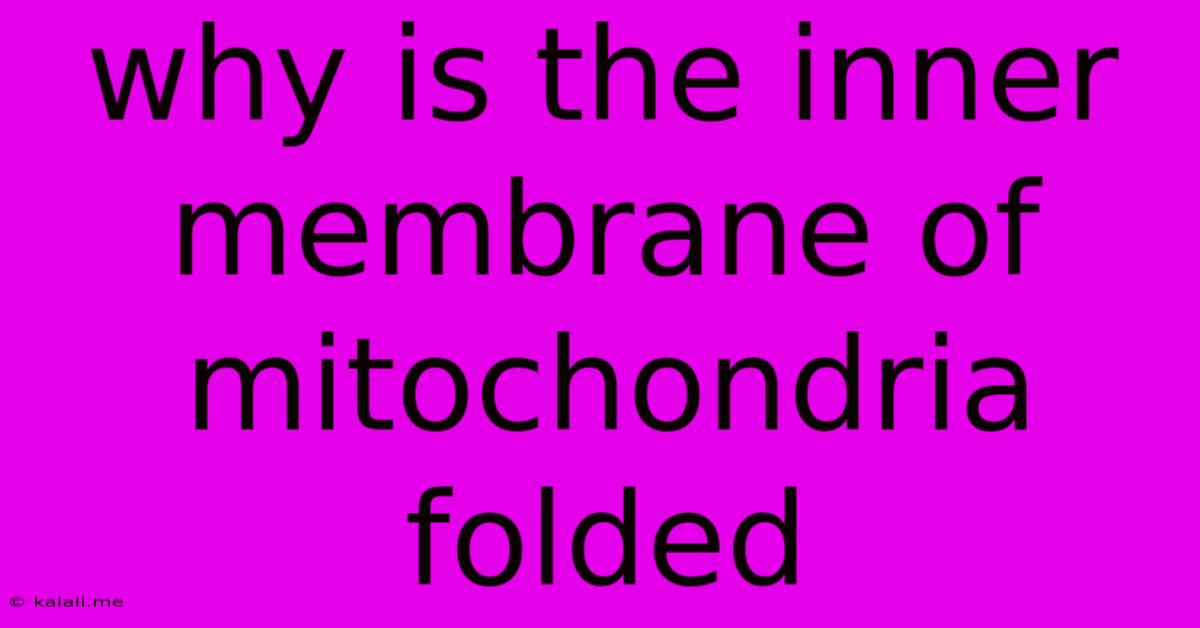Why Is The Inner Membrane Of Mitochondria Folded
Kalali
May 09, 2025 · 3 min read

Table of Contents
Why is the Inner Mitochondrial Membrane Folded? Maximizing Energy Production
The inner mitochondrial membrane, a critical component of cellular respiration, isn't just a smooth, continuous layer. Instead, it's dramatically folded into structures called cristae. This intricate folding isn't random; it's a crucial adaptation that significantly boosts the efficiency of ATP production, the cell's primary energy currency. Understanding the reasons behind this folding is key to understanding how mitochondria, the powerhouses of the cell, function.
This article will delve into the structural and functional reasons why the inner mitochondrial membrane is folded, exploring the advantages this unique morphology provides for cellular energy production and overall cellular health.
Increased Surface Area: The Key Advantage
The most significant reason for the inner mitochondrial membrane's folding is the dramatic increase in surface area it provides. Consider this: the processes involved in ATP synthesis, specifically the electron transport chain and chemiosmosis, occur on the inner mitochondrial membrane. Folding the membrane into cristae dramatically increases the available space for these crucial processes to take place simultaneously. This significantly amplifies the cell's capacity to generate ATP, meeting the high energy demands of various cellular activities. Think of it like expanding a factory floor – more space means more production.
Efficient Organization of the Electron Transport Chain
The inner mitochondrial membrane houses a series of protein complexes that constitute the electron transport chain (ETC). These complexes are precisely arranged along the membrane to facilitate the sequential transfer of electrons. The folded nature of the cristae helps to optimize the spatial arrangement of these complexes, ensuring efficient electron flow and maximizing the generation of a proton gradient, essential for ATP synthesis via ATP synthase. This highly organized structure minimizes diffusion distances and improves the overall kinetics of the ETC.
Regulation of Apoptosis and Mitochondrial Dynamics
Beyond ATP production, the cristae structure also plays a role in regulating apoptosis (programmed cell death) and mitochondrial dynamics (fusion and fission). The morphology and organization of the cristae can be altered in response to cellular stress or signals initiating apoptosis. Specific proteins involved in these processes are localized within the cristae, highlighting their importance in regulating cellular life and death. The intricate folding creates distinct microdomains within the mitochondria, allowing for specialized functions and compartmentalization.
Cristae Morphology and Disease
The shape and organization of cristae are not static; they are highly dynamic and can vary depending on the cell type and metabolic state. Alterations in cristae morphology have been linked to various diseases, including neurodegenerative disorders, cardiomyopathies, and cancer. Understanding the mechanisms governing cristae formation and maintenance is crucial for developing effective therapies for these conditions. Research continues to explore the precise relationship between cristae structure and mitochondrial dysfunction in disease pathogenesis.
Conclusion: A Masterpiece of Cellular Engineering
The folded inner mitochondrial membrane, with its characteristic cristae, isn't merely a structural curiosity; it's a testament to the elegance and efficiency of cellular design. By dramatically increasing surface area, optimizing the organization of the electron transport chain, and playing a role in apoptosis and mitochondrial dynamics, the cristae architecture ensures the efficient generation of ATP, fueling cellular processes and supporting life itself. Future research will undoubtedly continue to unravel the complexities of this remarkable cellular structure and its vital role in health and disease.
Latest Posts
Latest Posts
-
What Is The Lcm Of 11 And 7
May 09, 2025
-
Cuanto Es 60 Centimetros En Pies
May 09, 2025
-
Can I Desolve In 1 Gallon Water
May 09, 2025
-
What Is 125 Minutes In Hours
May 09, 2025
-
How To Find Range On A Dot Plot
May 09, 2025
Related Post
Thank you for visiting our website which covers about Why Is The Inner Membrane Of Mitochondria Folded . We hope the information provided has been useful to you. Feel free to contact us if you have any questions or need further assistance. See you next time and don't miss to bookmark.